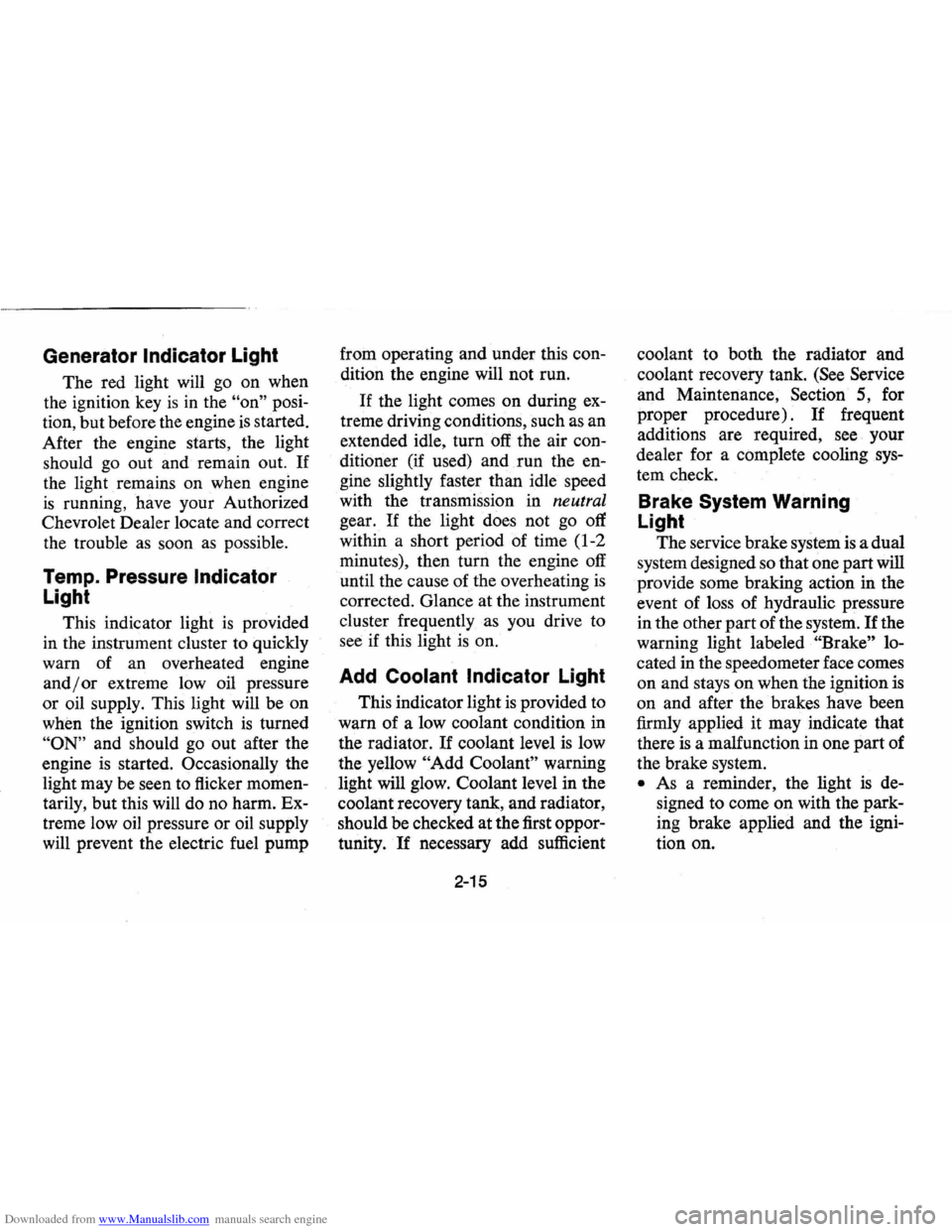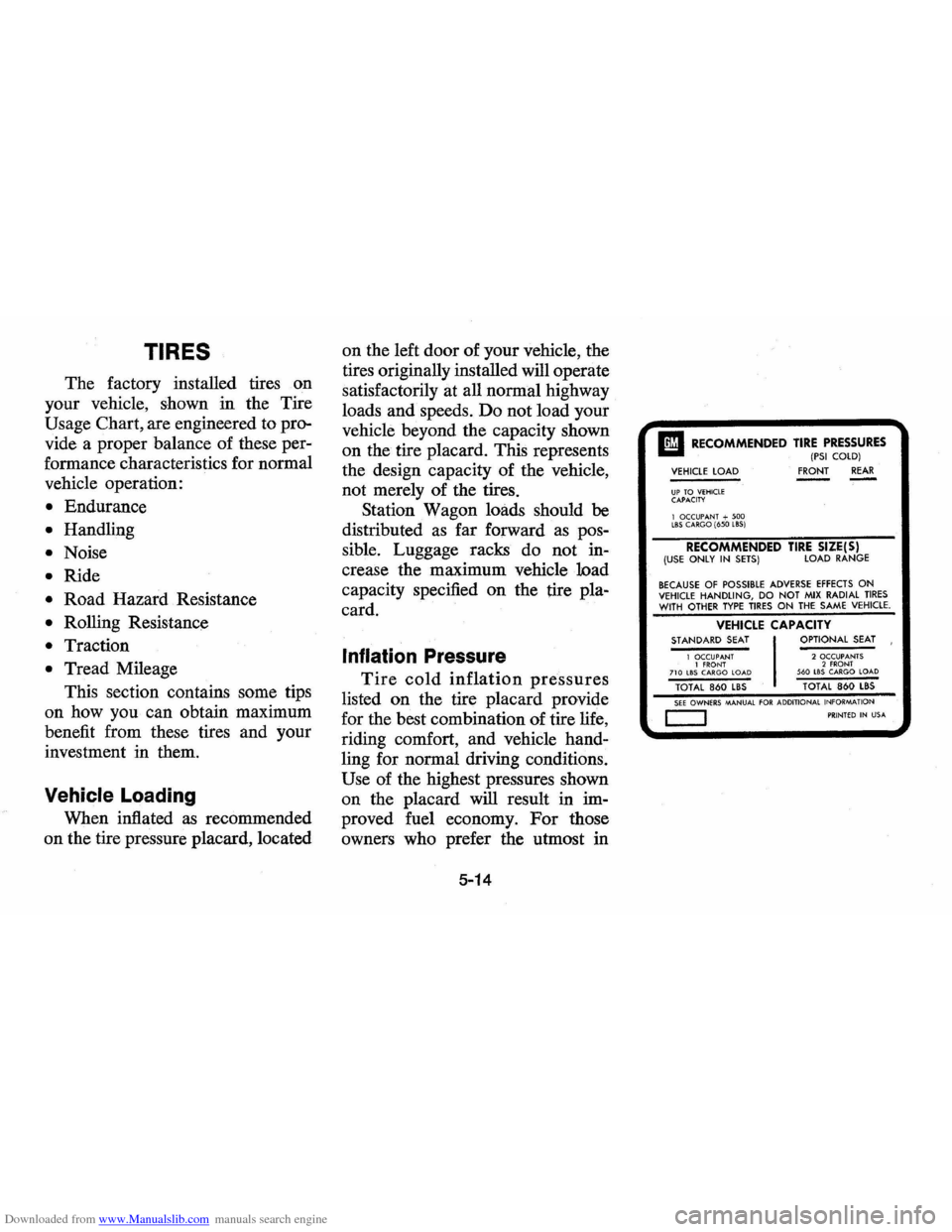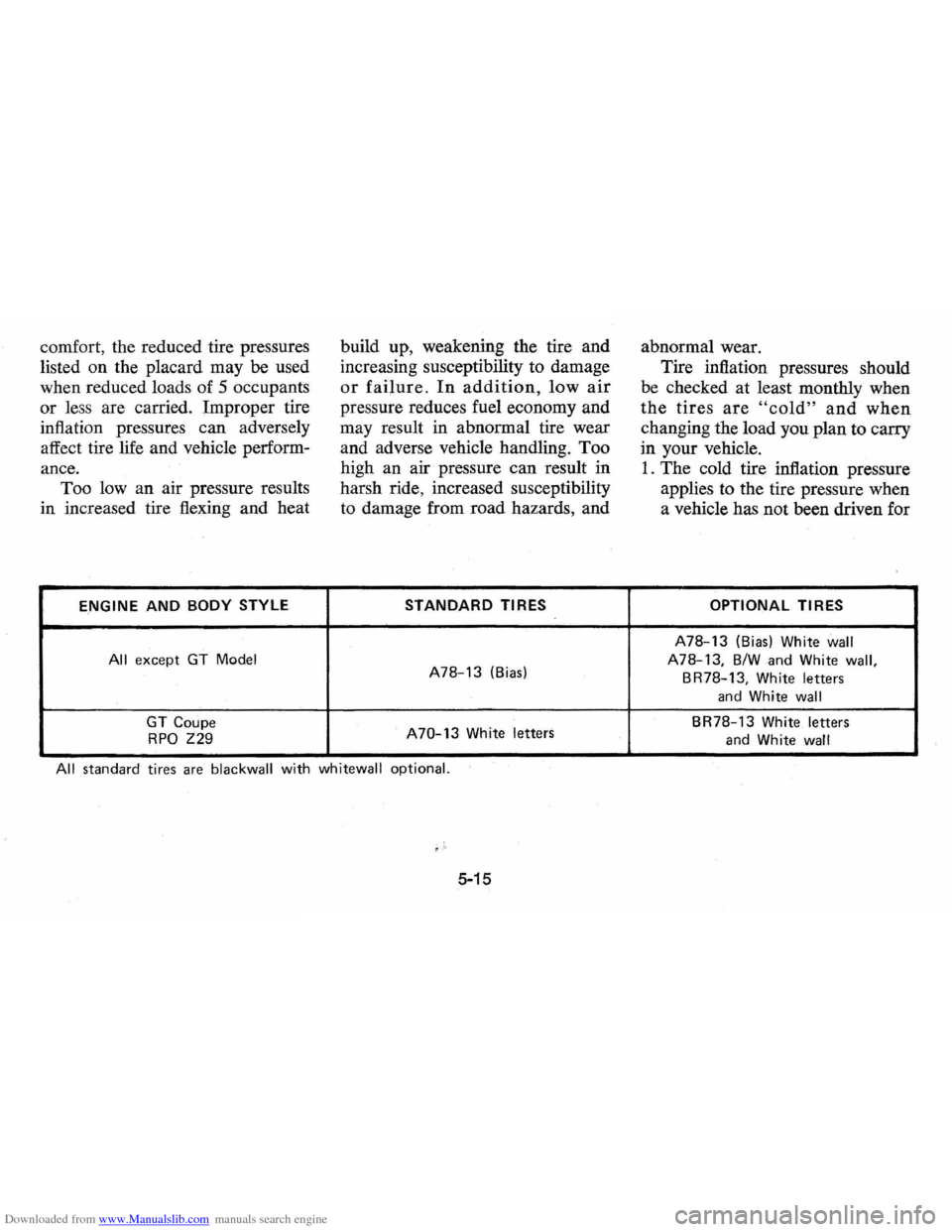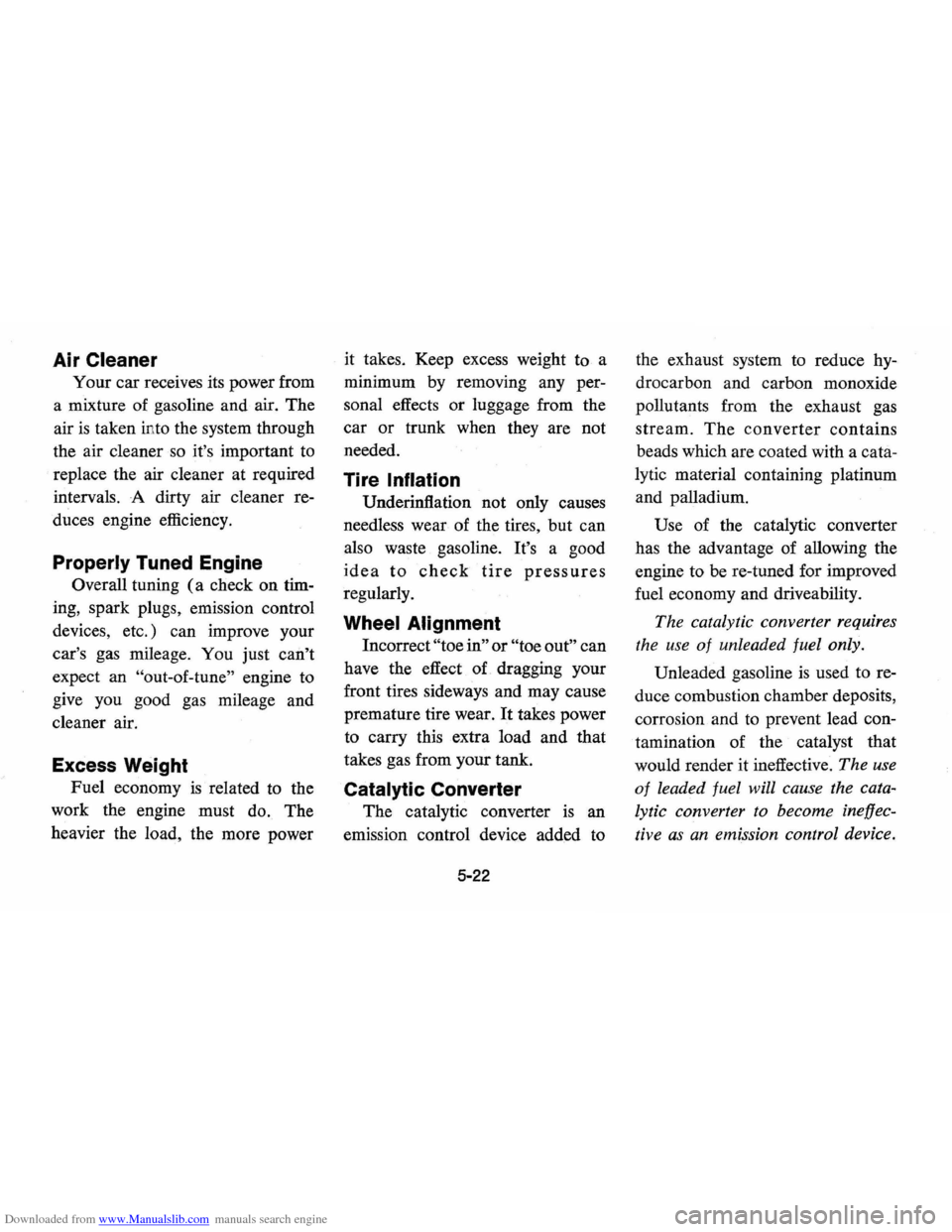1976 CHEVROLET VEGA fuel pressure
[x] Cancel search: fuel pressurePage 20 of 87

Downloaded from www.Manualslib.com manuals search engine Engine Flooded
Depress accelerator pedal and
hold to floor while starting until en
gine
is cleared of excess fuel and is
running smoothly. Never "pump"
the accelerator pedal.
Warm-Up
Always let the engine idle for 20
to 30 seconds after starting and
drive at moderate speeds for sev
eral miles, especially during cold
weather.
Driving with the Chevrolet Automatic Transmissions
The Turbo Hydra-Matic is a
completely automatic transmission
that replaces the standard clutch
and transmission.
After starting the engine with the
floor selector lever in N (Neutral)
or
P (Park) position select the
range desired (see table) and de
press the accelerator.
A gradual start with a steady in
crease in accelerator pressure will
result in best possible fuel economy.
Rapid acceleration for fast starts
will result in greater fuel consump
tion.
Automatic transmission shift
quadrants of all GM cars continue
the uniform sequence of selector
positions. This particularly benefits
multicar families and those who oc
casionally drive other cars.
Shift in
dicators are arranged with
"Park"
position at one end, followed in se
quence by
"Reverse", "Neutral"
and the forward driving ranges.
All automatic transmissions are
equipped with a starter safety switch
designed to permit starting the en
gine only when the transmission
is
in the "Park" or "Neutral" position.
For additional engine braking ef-
2-4
fect, as sometimes needed in moun
tainous driving, place the transmis
. sion in low range.
Page 31 of 87

Downloaded from www.Manualslib.com manuals search engine Generator Indicator Light
The red light will go on when
the ignition key
is in the "on" posi
tion, but before the engine
is started.
After the engine starts, the light
should go out and remain out.
If
the light remains on when engine
is running, have your Authorized
Chevrolet Dealer locate and correct
the trouble
as soon as possible.
Temp. Pressure Indicator
Light
This indicator light is provided
in the instrument cluster to quickly
warn of an overheated engine
and/or extreme low oil pressure
or oil supply. This light will be on
when the ignition switch is turned
"ON" and should go out after the
engine
is started. Occasionally the
light may be seen to flicker momen
tarily, but this will do no harm. Ex
treme low oil pressure or oil supply
will prevent the electric fuel pump from
operating and under this con
dition the engine will not run.
If the light comes on during ex
treme driving conditions, such
as an
extended idle, turn off the air con
ditioner (if used) and run the en
gine slightly faster than idle speed
with the transmission in
neutral
gear. If the light does not go off
within a short period of time (1-2
minutes), then turn the engine off
until the cause of
the overheating is
corrected. Glance at the instrument
cluster frequently
as you drive to
see if this light is on.
Add Coolant Indicator Light
This indicator light is provided to
warn of a low coolant condition in
the radiator.
If coolant level is low
the yellow
"Add Coolant" warning
light will glow. Coolant level in the
coolant recovery tank, and radiator,
should be checked at the first oppor
tunity.
If necessary add sufficient
2-15
coolant to both the radiator and
coolant recovery tank.
(See Service
and Maintenance, Section 5, for
proper procedure) .
If frequent
additions are required, see your
dealer for a complete cooling sys
tem check.
Brake System Warning
Light
The service brake system is a dual
system designed so that one part will
provide some braking action in the
event of loss of hydraulic pressure
in the other part of the system.
If the
warning light labeled
"Brake" lo
cated in the speedometer face comes
on and stays
on when the ignition is
on and after the brakes have been
firmly applied
it may indicate that
there
is a malfunction in one part of
the brake system.
• As a reminder, the light is de
signed to come
on with the park
ing brake applied and the igni
tion on.
Page 60 of 87

Downloaded from www.Manualslib.com manuals search engine Gas Cap-The fuel tank filler cap
has a
two-step removal and in
stallation procedure plus a pres
sure-vacuum safety relief valve. It
is equipped with a double set of
locking tangs. To remove:
• Rotate cap one-half tum counter
clockwise to clear the first set of
tangs from the slots inside the
filler neck. This will allow any
residual pressure to escape.
• Pull the cap outward and rotate
one-quarter
tum counterclock
wise to clear second set of tangs
and remove the cap.
• To install, reverse this procedure.
NOTE: If this cap requires a re
placement, only a cap with these
same features should be used.
Fail
ure to use the correct cap can result
in a serious malfunction of the
sys
tem. Correct replacement caps may
be obtained from your authorized
Chevrolet dealer.
ENGINE ITEMS
Engine Oil and Filter
Recommendations'
• Use only SE engine oil.
• Change oil each 6 months or
7,500 miles, whichever occurs
first,
except under the following
conditions:
*
-driving in dusty conditions
-trailer pulling
-extensive idling
-short-trip operation at
freez
ing temperatures (engine not
thoroughly warmed-up) .
*Under these conditions, change oil
each 3 months
or 3,000 miles,
whichever occurs first.
• Operation in dust storms may
require an immediate oil change.
• Replace the oil filter at the first
oil change, and every second oil
change thereafter. AC oil filters
5-2
provide excellent engine pro
tection.
See your Chevrolet dealer for
ad
vice on the frequency of oil and
filter changes under unusual driving
conditions.
The above recommendations
ap
ply to the first change as well as
subsequent oil changes. The oil
change interval for your Chevrolet
engine
is based on the use of SE
oils and quality oil filters.
Oil
change intervals longer than those
listed above will seriously reduce
engine life and may affect
Chevro
let obligation under the provisions
of the
New Vehicle Warranty.
NOTE: Non-detergent and other
low quality oils are specifically not
recommended.
Only the use of SE
engine oils and proper oil and filter
change intervals assure you of
con
tinued proper lubrication of your
Chevrolet engine.
Page 72 of 87

Downloaded from www.Manualslib.com manuals search engine TIRES
The factory installed tires on
your vehicle, shown in the Tire
Usage Chart, are engineered to pro
vide a proper balance of these per
formance characteristics for normal
vehicle operation:
• Endurance
• Handling
• Noise
• Ride
• Road Hazard Resistance
• Rolling Resistance
• Traction
• Tread Mileage
This section contains some tips
on how you can obtain maximum
benefit from these tires and your
investment in them.
Vehicle Loading
When inflated as recommended
on the tire pressure placard, located on
the left door of your vehicle,
the
tires originally installed will operate
satisfactorily at all normal highway
loads and speeds. Do not load your
vehicle beyond the capacity shown
on the tire placard. This represents
the design capacity of the vehicle,
not merely of the tires.
Station Wagon loads should
be
distributed as far forward as pos
sible. Luggage racks do not in
crease the maximum vehicle load
capacity specified on the tire pla
card.
Inflation Pressure
Tire cold inflation pressures
listed on the tire placard provide
for the best combination of tire life,
riding comfort, and vehicle hand
ling for normal driving conditions.
Use of the highest pressures shown
on the placard will result in
im
proved fuel economy. For those
owners who prefer the utmost in
5-14
II RECOMMENDED TIRE PRESSURES (PSI COlD) VEHICLE lOAD FRONT REAR ----UP TO VEHICLE CAPACITY
1 OCCUPANT + 500 lBS CARGO (650 lBS)
RECOMMENDED TIRE SIZE(S) (USE ONLY IN SETS) LOAD RANGE
BECAUSE OF POSSIBLE ADVERSE EFFECTS ON VEHICLE HANDLING, DO NOT MIX RADIAL TIRES WITH OTHER TYPE TIRES ON THE SAME VEHICLE.
VEHICLE CAPACITY STANDARD SEAT OPTIONAL SEAT
1 OCCUPANT 2 OCCUPANTS 1 fRONT 2 FRONT 710 lBS CARGO LOAD 560 LBS CARGO LOAD TOTAL 860 lBS TOTAL 860 lBS SEE OWNERS MANUAL FOR ADDITIONAL
INFORMATION
c::J PRINTED IN USA
Page 73 of 87

Downloaded from www.Manualslib.com manuals search engine comfort, the reduced tire pressures
listed on the placard may
be used
when reduced loads of 5 occupants
or less are carried. Improper tire
inflation pressures can adversely
affect tire life and vehicle perform
ance. Too
Iowan air pressure results
in increased tire flexing and heat
ENGINE AND BODY STYLE
All except GT Model
GT Coupe
RPO Z29
build up, weakening the tire and
increasing susceptibility to damage
or failure. In addition, low air
pressure reduces fuel economy and
may result in abnormal tire wear
and adverse vehicle handling. Too
high an air pressure can result in
harsh ride, increased susceptibility
to damage from road hazards, and
STANDARD TIRES
A78-13 (Bias)
A70-13 White letters
All standard tires are blackwall with whitewall optional.
f'"
5-15
abnormal wear.
Tire inflation pressures should
be checked at least monthly when
the tires are "cold" and when
changing the load you plan to carry
in your vehicle.
1. The cold tire inflation pressure
applies to the tire pressure when
a vehicle has not been driven for
OPTIONAL TIRES
A78-13 (Bias) White wall
A78-13, B/W and White wall,
BR78-13, White letters
and White wall
BR78-13 White letters
and White wall
Page 80 of 87

Downloaded from www.Manualslib.com manuals search engine Air Cleaner
Your car receives its power from
a mixture of gasoline and air. The
air
is taken in to the system through
the air cleaner
so it's important to
replace the air cleaner at required
intervals. A dirty air cleaner re
duces engine efficiency.
Properly Tuned Engine
Overall tuning (a check on tim
ing, spark plugs, emission control
devices, etc.) can improve your
car's gas mileage. You just can't
expect an
"out-of-tune" engine to
give you good gas mileage and
cleaner air.
Excess Weight
Fuel economy is related to the
work the engine must do. The
heavier the load, the more power it
takes. Keep excess weight to a
minimum by removing any per
sonal effects or luggage from the
car or trunk when they are not
needed.
Tire Inflation
Underinfiation not only causes
needless wear of the tires, but can
also waste gasoline. It's a good
idea to check tire pressures
regularly.
Wheel Alignment
Incorrect "toe in" or "toe out" can
have the effect
of dragging your
front tires sideways and may cause
premature tire wear.
It takes power
to carry this extra load and that
takes gas from your tank.
Catalytic Converter
The catalytic converter IS an
emission control device added to
5-22
the exhaust system to reduce hy
drocarbon and carbon monoxide
pollutants from the exhaust gas
stream.
The converter contains
beads which are coated with a cata
lytic material containing platinum
and palladium.
Use of the catalytic converter
has the advantage of allowing the
engine to be re-tuned for improved
fuel economy and driveability.
The catalytic converter requires
the use
of unleaded fuel only.
Unleaded gasoline is used to re
duce combustion chamber deposits,
corrosion and
to prevent lead con
tamination of the catalyst that
would render it ineffective.
The use
of leaded fuel will cause the cata
lytic converter to
become ineffec
tive as an emission control device.